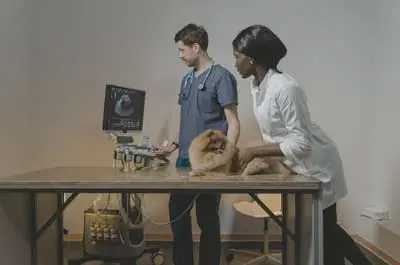If you think your dog may be pregnant, it’s essential to know the signs and symptoms. Many dog owners are unsure what to do when their pet becomes pregnant, so we’ve put together a guide on how to tell if your dog is pregnant, what to expect, and what you need to do for her during pregnancy. Keep reading for more information!
What are the signs and symptoms of a pregnant dog?
Pregnancy in dogs can last anywhere from 58 to 68 days, with the average being 63 days. During this time, you might notice a few things that could indicate that your dog is pregnant. One of the first signs is a change in appetite – either your dog will be hungrier than usual, or she may lose her appetite entirely. You might also notice that your dog’s nipples are larger and more pronounced, and she’s gaining weight. As her due date approaches, you may see your dog nesting or become more restless.
Pregnant dogs usually show physical and behavioral changes, generally divided into three stages: early, middle, and late.
During the early stage of pregnancy, which lasts approximately three weeks, the dog’s body prepares for pregnancy. She will usually lose her appetite, and her nipples will become more pronounced. You may also notice that your dog is gaining weight as she develops a little “paunch.”
In the middle stage of pregnancy, which lasts from weeks four to six, the dog’s abdomen will start to enlarge as her puppies begin to grow. She will gain even more weight, and her appetite will usually return. You may also notice that your dog is nesting at this time – she may start digging in her bedding or looking for a quiet, secluded spot to rest.
The late stage of pregnancy lasts from week seven until the day your dog gives birth. She will be huge at this point, and her nipples will leak milk. You may also notice that she is less active than usual and is panting more frequently. This is normal, as her body works hard to support her growing puppies.
How long after mating will a female dog show signs of being pregnant?
It usually takes about six weeks after mating for a female dog to show signs of pregnancy. Others may take a few weeks to notice anything different. However, some dogs may not show any physical changes until they are further in their pregnancy. And still, others may not show any outward signs at all until they are ready to give birth.
If you’re unsure whether your dog is pregnant, it’s best to wait until she’s at least eight weeks before getting her checked out by a vet. By that point, the vet can feel the puppies inside her and give you a better idea of how many there are and when they’re due.
When should you take your dog to the vet for a pregnancy checkup?

If you believe your dog is expecting, you should take her for a confirmation ultrasound. This will help us estimate the due date and number of puppies. Her veterinarian is the best source of advice on what to do for your pregnant dog.
After the ultrasound, your vet will likely schedule you for another appointment in four to six weeks so that they can check on the progress of your dog’s pregnancy. At this point, they will be able to feel the puppies and determine their approximate size and number.
Your dog will need a few more checkups during her pregnancy, and you should take her to the vet immediately if you notice any changes in her condition or if she seems to be in pain.
How can you help your pregnant dog?
Once you learn your dog is expecting, you can take steps to ensure her health and comfort during the pregnancy and beyond. In the beginning, you should try adjusting her food. She’ll have increased nutritional needs, so discuss with the veterinarian the possibility of switching her to a special pregnancy-formula dog food. Be sure she has enough fresh water to drink.
You’ll need to take extra care of your dog during her pregnancy, including giving her more frequent baths and brushing her coat more often. You’ll also need to provide her with a comfortable place to rest and sleep, and you may want to consider getting a doggy pregnancy pillow to help support her belly.
As your dog’s due date approaches, you’ll need to be prepared for her labor. This includes having everything you need on hand, such as a clean towel, Clippers (to cut the umbilical cord), and gauze (to stop any bleeding). You should also have someone on hand who can help you during the delivery, just in case anything goes wrong.
What are the risks associated with giving birth to puppies if your dog is not adequately cared for during pregnancy and delivery?

If your dog is not properly cared for during pregnancy and delivery, there are many risks associated with giving birth to puppies.
These risks include:
- Puppies being born too early or too late
- They born dead or stillborn
- Puppies being born with birth defects or health problems
- Bleeding from the uterus during or after delivery
- Infection of the uterus during or after delivery
- Injury to the uterus during delivery
- Excessive bleeding from the vulva during or after delivery
- Tearing of the vagina or vulva during delivery
- Infection of the reproductive tract after delivery
Proper care during pregnancy and delivery can minimize all of these risks, so it is vital to ensure your dog gets the care she needs. If you have any concerns, please talk to your veterinarian.
What should you do if you think your dog is pregnant but has not been mated by a male dog?
Do not delay taking your dog in for an ultrasound if you suspect she may be pregnant but has not been mated with a male dog. This will help to confirm whether or not she is pregnant and, if so, how many puppies she is carrying.
If your dog is not pregnant, the vet can help you determine the cause of her symptoms and recommend a course of treatment. Here are some possible causes of false pregnancy in dogs:
- Pyometra (infection of the uterus)
- Cystic endometrial hyperplasia (an overgrowth of the lining of the uterus)
- Tumors of the uterus or ovaries
- Psychological factors such as stress or separation anxiety
What are the signs that your dog is in labor?
It’s important to keep an eye out for these frequent indicators, but remember that they may vary somewhat from dog to dog.
These include:
- Nesting or digging behavior
- Loss of appetite
- Restlessness or pacing
- Panting or heavy breathing
- Shivering or shaking
- vomiting or retching (dry heaving)
- Discharge from the vulva that is pink, clear, or bloody
- Contractions of the abdomen
- Bears down or strain with contractions
Please see your veterinarian immediately if you observe any of these symptoms. For more detailed guidance on how to aid your dog during birth, it’s best to consult with a professional.
The birth process and what to do afterward.
Once your dog goes into labor, she will start to have contractions to help push the puppies out. Birthing time for the first puppy is often longer than for subsequent litters. Once a puppy is born, the umbilical cord must be cut and tied off. After all the puppies are born, your dog will deliver the placentas. It is important to save these in case your vet needs to examine them later.
After delivery, it is vital to watch your dog and puppies. Make sure they are all nursing and that your dog is not showing any signs of distress. If everything seems fine, you can relax and enjoy your new furry family! However, if you have any concerns, contact your veterinarian immediately.
You’ll need to puppy-proof your home in anticipation of the new arrivals.
Puppy-proofing your home is a critical step to take before your new arrivals come home. This means ensuring that all potentially dangerous items are out of reach, including things like cleaning products, electrical cords, and small objects that could be swallowed. You’ll also need to ensure that there are no escape routes for the puppies so they don’t get lost or hurt. This is crucial in keeping your new family safe and healthy. With some preparation, you can ensure everyone has a happy and enjoyable experience.
Have also a plan for after the puppies are born. They must stay warm and have plenty of food and water. Your dog will likely take care of them for the first few weeks, but you’ll need to be prepared to step in if necessary. Congratulations again on your new furry family!
Enjoying your new furry family!
Having a new litter of puppies is an exciting time for any dog owner! Be sure to take lots of pictures and enjoy watching your puppies grow and change daily. It’s a beautiful experience you will cherish for many years.
Be prepared to give extra cuddles and kisses to your furry family – after all, they’ll need all the love they can receive at this wonderful time!
Enjoying your new furry family won’t be without challenges, but it will surely be rewarding. With a bit of planning, you’ll be ready for anything that comes your way.
Conclusion.
Having a pregnant dog is joyful, but you should also be ready for the challenges ahead. If you follow these guidelines, your pregnant dog has a better chance of having a happy and healthy pregnancy.
Please don’t hesitate to call your vet if you have any questions or concerns regarding your dog or pups. You may count on their help and encouragement at every turn of this thrilling period!
Thanks for reading. We hope you found this post helpful. If so, please share it with your friends!

Meet Marcella Raskin: Founder, Editor-in-Chief, and a Maven in Human Potential
Dive into the rich tapestry of Marcella Raskin’s life and you’ll discover more than just an editor-in-chief. At the core, Marcella is a passionate writer, deeply committed to unlocking the boundless human potential. Armed with expertise in Cognitive Behavioral Therapy, Life Purpose Coaching, and Group Life Coaching, she’s carved a niche in helping both women and men unearth their true selves through the art of writing. Every article she pens is a gateway, inviting readers to shift mindsets and embrace transformation, even when change seems impossible.
Beyond her literary pursuits, Marcella is a fitness enthusiast, underpinned by her background in Exercise Physiology. And when she’s not empowering others or delving into the science of movement, she’s reveling in the joys of motherhood, raising two incredible girls, and sharing life’s moments with her beloved spouse.
Trust Marcella’s words; they’re backed by expertise, passion, and a journey full of learning and growth.
Reviewed By: Joanna Perez and Brenda Tillman
Edited By: Lenny Terra
Fact Checked By: Matthew Mansour
Photos Taken or Curated By: Matthew Mansour